FBA vs FBM: Which is Better for Amazon Sellers?
Download Amazon Seller Guide
This guide will help you get started, understand the basics of Amazon selling, and explain in simple words how it all works.

If you are an Amazon seller deciding how to fulfill your customer orders, you have two main choices: Fulfillment by Amazon (FBA) and Fulfillment by Merchant (FBM). With FBA, Amazon takes care of the product fulfillment for a fee, while with FBM you do it yourself.
Both methods have their advantages and disadvantages. You can choose FBA or FBM, depending on your product or business model, or combine both.
This post explores the key differences between FBA and FBM, including their benefits, challenges, and ideal use cases, to help you decide which is the better fit for your business.
What Is the Difference between Amazon FBA and FBM?
Fulfillment by Amazon (FBA) and Fulfillment by Merchant (FBM) are the two main fulfillment methods on Amazon. The main difference between FBA vs. FBM is about who handles the storage, picking, packaging, and shipping of your products to Amazon customers.
Fulfillment by Amazon
In this model, you send your inventory to Amazon warehouses. Amazon then stores your products, picks and packs them when a customer orders, and ships them directly to the customer. Amazon also handle returns and customer service for those orders.
All of that is done for a fee.
.avif)
Things to remember about FBA
FBA is ideal for Amazon sellers who want to avoid the hassle of fulfillment, use Amazon’s logistics network, and increase chances to get the Buy Box. However, it’s essential to consider the associated costs.
Convenience and efficiency
Amazon takes care of storing, packing, and shipping your products. This service extends to customer service and returns.
Costs and fees
FBA involves various fees, including storage fees, fulfillment fees per unit, and long-term storage fees, inbound placement storage fees, and more. These can add up, especially for slow-moving inventory. Therefore, you must maintain a fast inventory turnover rate to avoid long-term storage fees
Increased visibility
FBA products often rank higher in search results/ Additionally, FBA products are more likely to win the Featured Offer (Buy Box), which can lead to increased sales.
Customer support
Amazon provides 24/7 customer support and handles all customer inquiries and issues. Also, Amazon manages returns, which simplifies the process for FBA sellers but may involve restocking fees and returns handling fees.
Stringent prep requirements
The products you send to Amazon FBA must meet Amazon’s packaging and labeling requirements before being shipped to the Amazon fulfillment center.
Fulfillment by Merchant
With FBM, you handle everything related to product fulfillment yourself. You store your inventory, package and ship orders when they come in, and manage returns or customer service issues, if any.
.avif)
If you have a lot of inventory you can’t process and store yourself, you can outsource the majority of fulfillment tasks to third-party service providers (3PL), who will prepare the inventory and ship it. They will also charge you for that, but in some cases their service may be cheaper than Amazon FBA.
Things to remember about FBM
FBM is suitable for sellers who prefer maintaining control over their fulfillment and returns, have the capacity to manage their own storage and shipping, or sell products that do not fit well with FBA. While it offers cost savings and flexibility, it also demands management effort and operational efficiency.
Control and flexibility
FBM sellers manage their own inventory and shipping processes. You can choose your preferred carriers and shipping methods, which can be advantageous for handling fragile or heavy and bulky items.
Cost management
With FBM, you don’t have to pay Amazon fulfillment and storage fees, potentially reducing overall costs, especially exclusive, small-volume, low-margin, or hard-to-ship products.
However, you’ll need to cover your own storage, packing, shipping, and customer service expenses.
Inventory management
You must handle the storage of your products, which can be an advantage if you have access to low-cost storage or a disadvantage if you lack space.
Capacity to scale
Scaling up can be more challenging without Amazon’s infrastructure, requiring investment in storage, packing, and shipping capabilities as your business grows.Consider integrating with third-party logistics (3PL) providers to maintain efficiency.
Returns management
You manage all aspects of the returns process, including restocking and customer communications, which requires an efficient system to handle returns promptly. However, you have more control over the returned inventory than FBA sellers.
Pros and Cons of Amazon FBA and FBM
FBA and FBM offer advantages and challenges, and the best choice depends on your product type and business scale. FBA is ideal for sellers who want to reach many customers with minimal operational hassle. FBM is suited for sellers who want more control over their fulfillment process, can handle logistics, and prefer lower fees.
Pros of Amazon FBA
.avif)
Effortless logistics
With FBA, sellers send their products to Amazon fulfillment centers. When a shopper makes a purchase, Amazon picks, packs, and ships the order, which means Amazon handles a big part of the delivery process on behalf of a seller.
Also, sellers who enroll products in FBA are eligible for Amazon Prime free two-day shipping. That is a competitive edge since many buyers use Amazon because of this option.
Outsourcing customer service and returns
Amazon provides customer service on behalf of Amazon FBA sellers. It handles customer support via phone or email 24/7. The service is free. Also, Amazon manages returns for FBA sellers.
Buy Box priority
Amazon prioritizes FBA sellers regarding product ranking in search results, visibility, and winning the Buy Box. When you use the FBA, your item will appear higher on the Amazon search results page and is more likely to win the Buy Box. Thus, it will sell more.
Related: What is Buy Box? How to win Buy Box on Amazon
Cons of Amazon FBA
.avif)
Substantial FBA fees
Though Amazon FBA is a convenient and efficient service, it costs money. Amazon charges sellers fulfillment and inbound placement service fees. Additionally, you pay storage fees, therefore, you must sell products quickly to move your stock and avoid long-term storage fees. There are also other FBA fees for packaging, processing returns, and more.
You must accurately account for all these fees and ensure that your product is still profitable after deducting all FBA fees.
Related: Amazon FBA Fees
Higher return rates
Amazon has a simplified return policy. That means a buyer can return most items purchased on Amazon for a full refund within 30 days. When customers request to return a product they bought via FBA, Amazon immediately takes the return funds from the seller's disbursement and gives the customer a shipping label to return the item to the proper warehouse.
Because of this easy customer returns procedure, FBA sellers can face increased return rates.
Strict prep guidelines
When delivering inventory to Amazon fulfillment centers, sellers must prep and label it in line with Amazon’s guidelines. They are very detailed, and you need to follow them strictly. If your items are not packaged and labeled according to Amazon standards, it will reject your inventory at the warehouse. That will lead to delays in delivery.
Pros of Amazon FBM

Full control over packaging
FBM sellers can pack their products in line with their promo and marketing approach. This is especially important for exclusive products. You can also add insert cards or any other marketing material. Customized packaging makes your products stand out against the competition and build customer loyalty.
Greater margins
With FBM, there's a much lower chance of incurring unexpected costs when using FBA. Also, you have fewer losses due to changes in Amazon policies. You don’t have to pay long-term storage fees or similar charges because you don’t use Amazon fulfillment centers. You can have pre-agreed terms and conditions with your shipping company and fully control your expected profits.
Freedom to run the business your own way
FBM gives you good control over your inventory and its tracking in the delivery process. Since you store all inventory in one place, it’s easier to monitor and track it. Also, you have a better idea at which stage of the shipping process your product is at a specific time frame.
You can select a shipping carrier and change the company if you don’t like their services. You can handle returns and refunds as you think necessary as well.
Cons of Amazon FBM
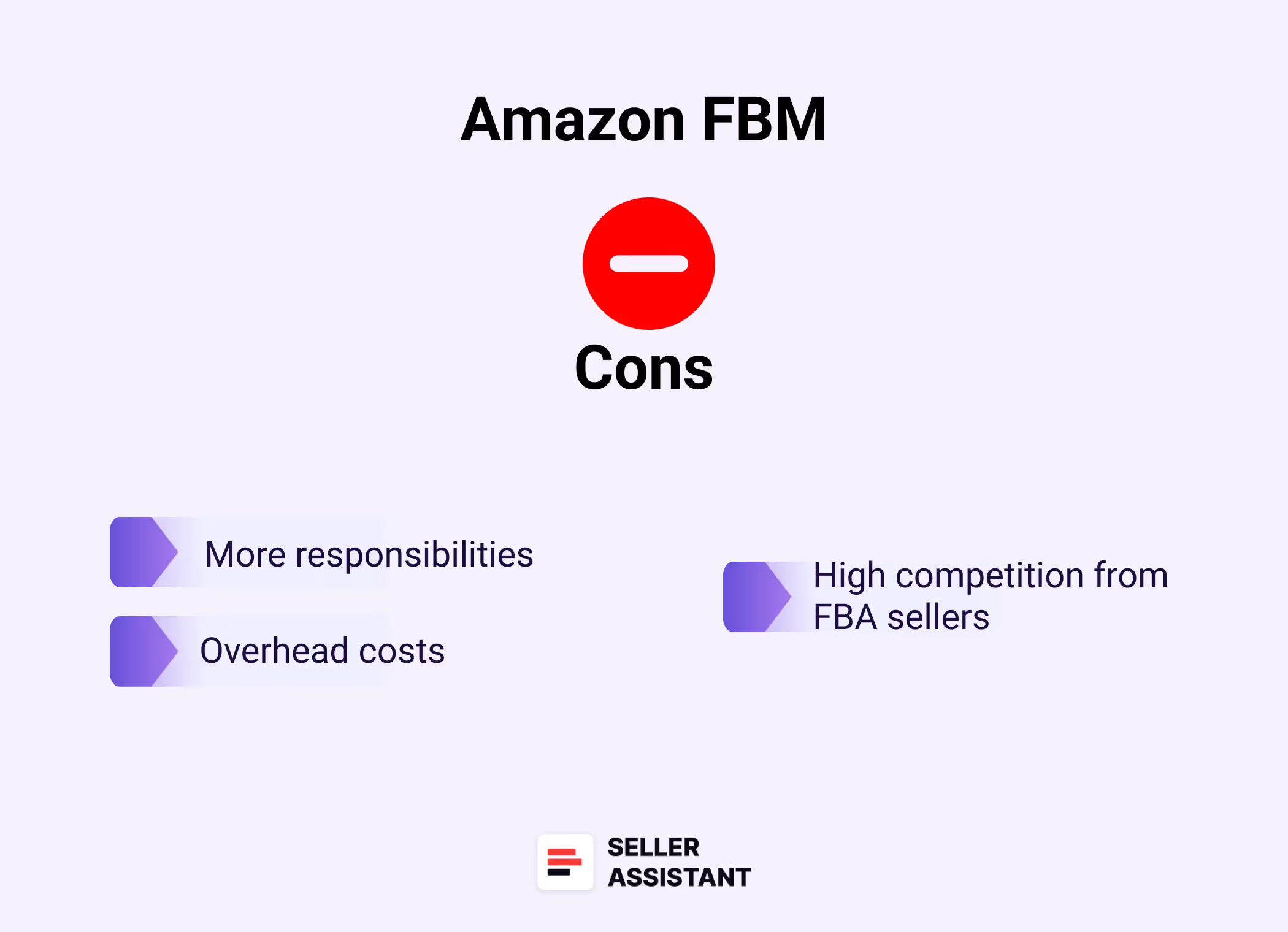
High competition from FBA sellers
In many instances, Amazon can prioritize FBA sellers, especially when it comes to winning the Buy Box. Therefore, you must be highly efficient and ready to price wars to be able to withstand the competition.
More responsibilities
One of the crucial disadvantages of using FBM is that you must take complete care of the logistics process. You are responsible for shipping products to buyers, which can take a lot of time, especially if you sell significant volumes.
Overhead costs
FBM involves certain overhead costs. For instance, you'll need to pay for packaging materials and shipping labels. Also, you'll need to have a way to track your inventory if your shipping company doesn’t offer that service.
6 Factors to Choosing between FBA and FBM
When you decide how to fulfill your product, start with looking at several factors that can help you make the right choice. You can find them below.
.avif)
Expected sales volume
High sales volumes can benefit from FBA due to Amazon’s extensive logistics network, which can handle large orders efficiently. FBM may be more cost-effective for lower sales volumes where the burden of fulfillment costs is less significant.
Tip. Choose FBA for scalability with high volumes; opt for FBM for controlled, lower volume sales.
Cost analysis
FBA involves various fees, including storage, fulfillment, and long-term storage fees. FBM typically incurs lower costs, but you will need to manage shipping and storage expenses.
Tip. Weigh FBA’s convenience against its fees; FBM might reduce costs if you handle logistics efficiently. Use Seller Assistant’s FBM and FBA Calculator to compare FBA and FBM costs.
Product type and size
Standard-sized products fit well with FBA’s pricing model. Non-standard, bulky, or heavy items may incur higher FBA fees, making FBM more attractive for such products.
Tip. Select FBA for standard products; consider FBM for non-standard or oversized items to avoid extra fees.
Product turnover rate
FBA charges long-term storage fees for slow-moving items, making it less suitable for products with low turnover rates. FBM avoids these fees, making it better for slower-selling items.
Tip. Use FBA for fast-selling products; FBM for items with lower turnover to avoid storage fees.
Profit margins
FBA fees can impact your profit margins, making FBM a better option if maintaining higher margins is a priority.
Tip. Choose FBA if the benefits outweigh the costs; FBM for tighter control over costs and higher potential profit margins.
Experience and resources
FBA simplifies logistics, which is beneficial if you lack expertise. FBM requires logistical knowledge and resources to manage fulfillment independently.
Tip. FBA is best for those who prefer not to handle logistics; FBM for sellers with experience and resources in logistics.
Which is better, FBA or FBM?
To make a choice between FBA and FBM, you can look at some examples showing when each method works the best. Below you can find some cases when FBA or FBM can typically be a better choice.
.avif)
When FBA is a better choice
You sell in large volumes
FBA can efficiently handle high sales volumes, helping you scale your business without logistical headaches. FBA is ideal for businesses aiming for rapid growth and large customer bases.
You prefer not to handle fulfillment
With FBA, Amazon takes care of packing, shipping, and customer service, freeing up your time. FBA is great for sellers who want to focus on product development or marketing.
You lack a shipping partner
Amazon's vast logistics network covers all shipping needs, removing the need to establish your own shipping agreements. FBA is perfect for new sellers who haven’t yet set up their own shipping infrastructure.
You don’t have storage space
FBA provides storage in Amazon’s warehouses, so you don’t need your own facilities. FBA is useful for sellers with limited physical space or those who want to avoid warehousing costs.
Your products fit standard size tiers
FBA is optimized for standard-sized items, making it cost-effective and straightforward. It is suitable for businesses with products that are within Amazon's size and weight limits.
You’re comfortable with FBA fees
FBA charges various fees for storage and fulfillment, which you need to be prepared to pay. It is good for those who can sacrifice additional costs for the convenience of outsourcing fulfillment.
When FBM is a better choice
Your products have slow turnover
FBM allows you to avoid long-term storage fees associated with slow-moving inventory. FBM is ideal for sellers with products that don’t sell quickly and require longer storage times.
You have logistics experience
Managing your own shipping and fulfillment is beneficial if you have logistical expertise. FBM is suitable for businesses that have established their own logistics processes and capabilities.
You have a reliable shipping partner
FBM works well if you have an existing relationship with a trusted shipping provider. It can be useful for sellers who can negotiate favorable rates and reliable services with their own shipping partners.
You have storage facilities
FBM is advantageous if you have your own warehouse or storage space. It is beneficial for businesses that can manage their inventory without the need for Amazon's warehousing.
Your products have non-standard sizes
FBM provides flexibility for products that don’t conform to Amazon’s size and weight categories. It can work for sellers with unique or oversized items that may incur higher FBA fees.
You seek higher profit margins
FBM can help you maintain higher margins by avoiding FBA fees. It can be more profitable for those looking to maximize profitability and reduce operational costs.
How to Choose between FBA and FBM?
The best way to choose between FBA and FBM is to calculate your expenses and see what’s more profitable. Simply compare Amazon FBA and FBM fees.
You can do that quickly and easily directly on the Amazon product pages or on any supplier website with Seller Assistant’s FBM&FBA Calculator. You have two options: FBA and FBM. You can quickly calculate product profitability, fees, and logistics expenses for FBA and FBM separately, and compare which one is more profitable.
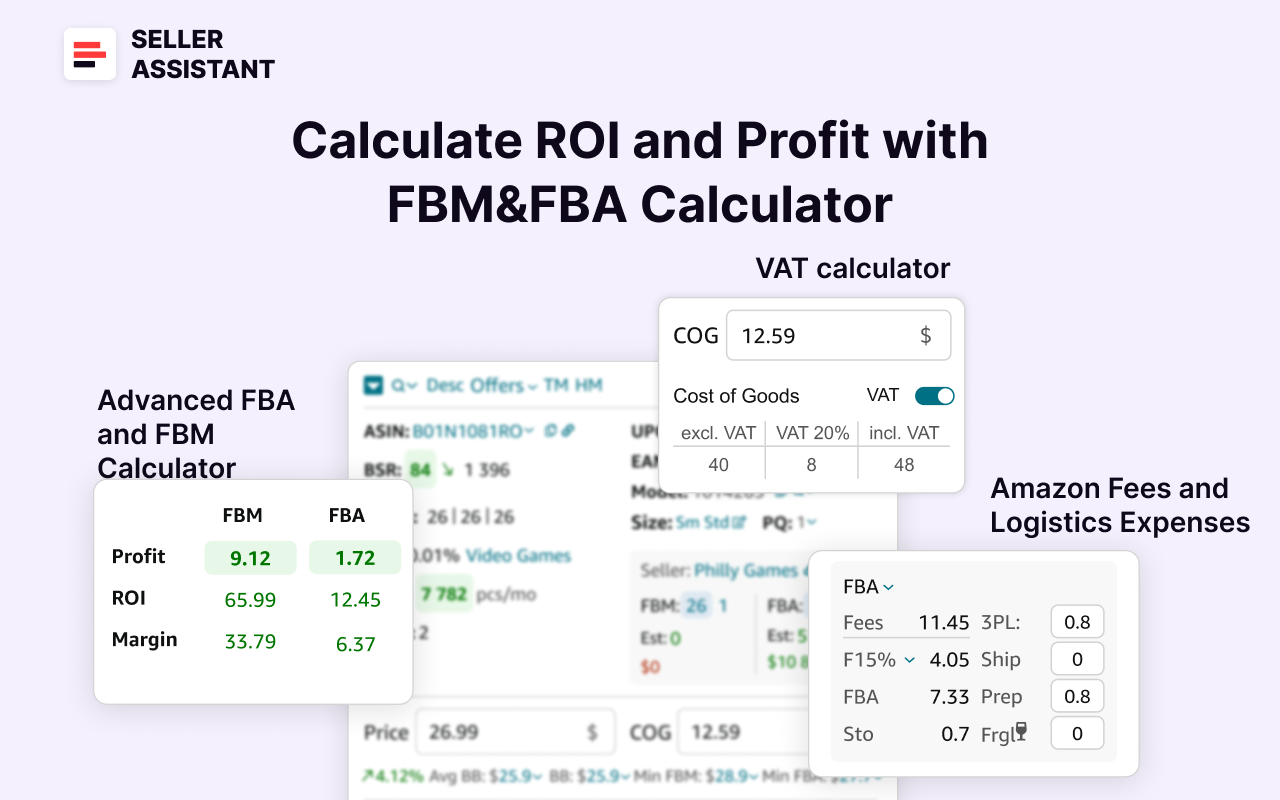
Steps to choose between FBA and FBM
Step 1. Enter the Cost of Goods Sold (product price at the supplier) in the COG field.
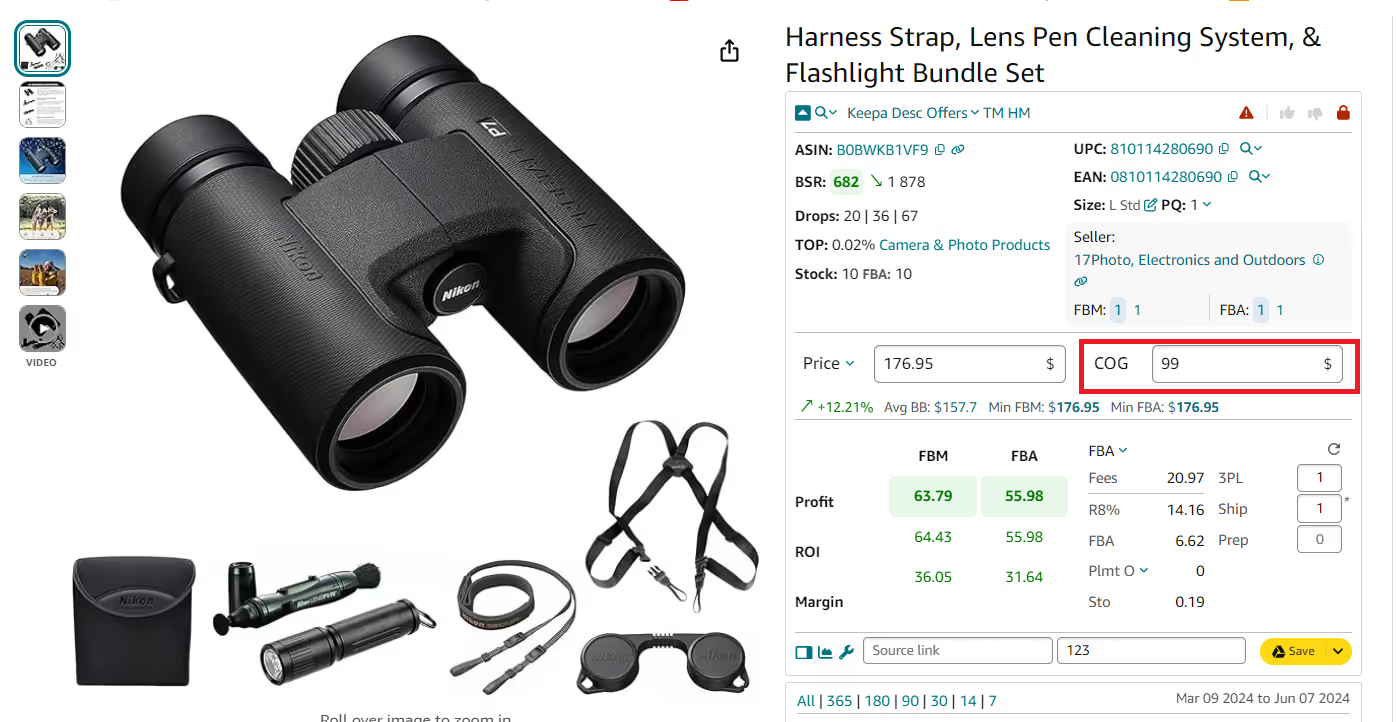
Step 2. Choose FBA or FBM option
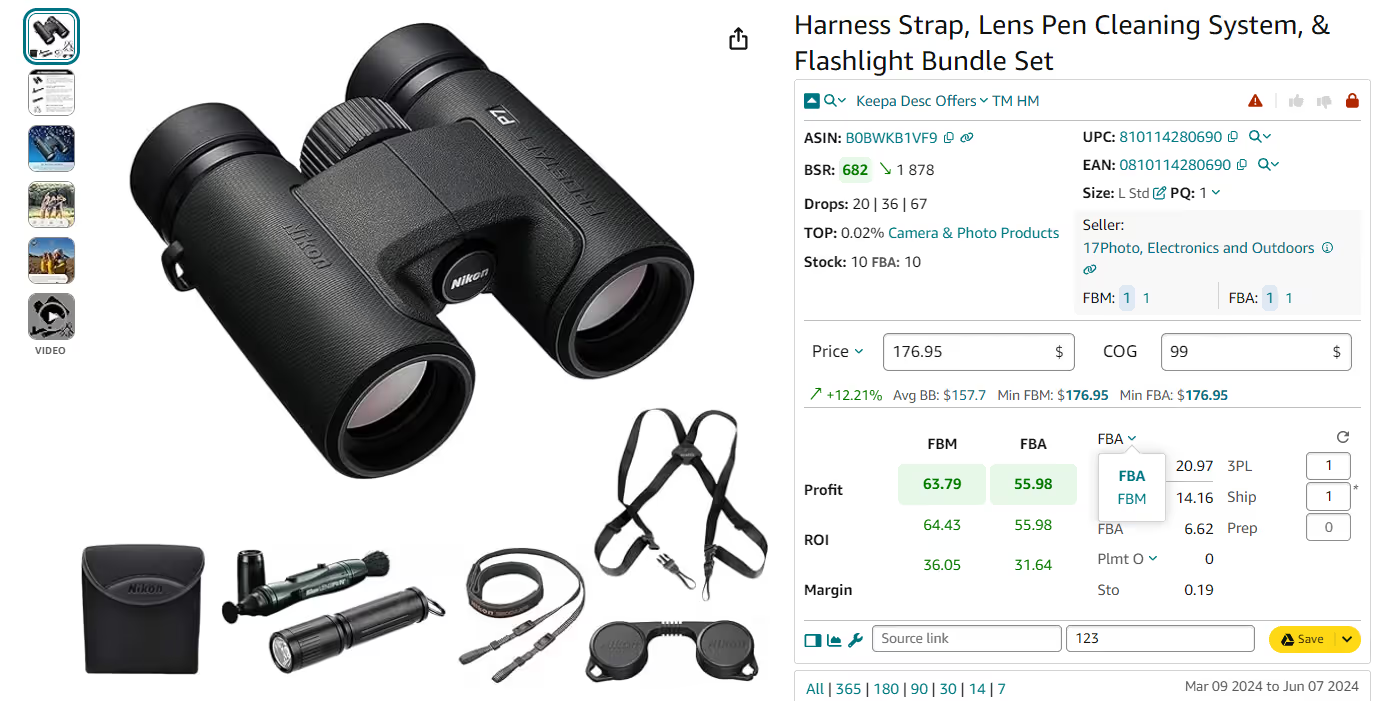
For FBA, you can choose the inbound placement fee option in the Plmt field (by default it is set to Optimized shipment split, $0). The calculator shows you all Amazon fees;
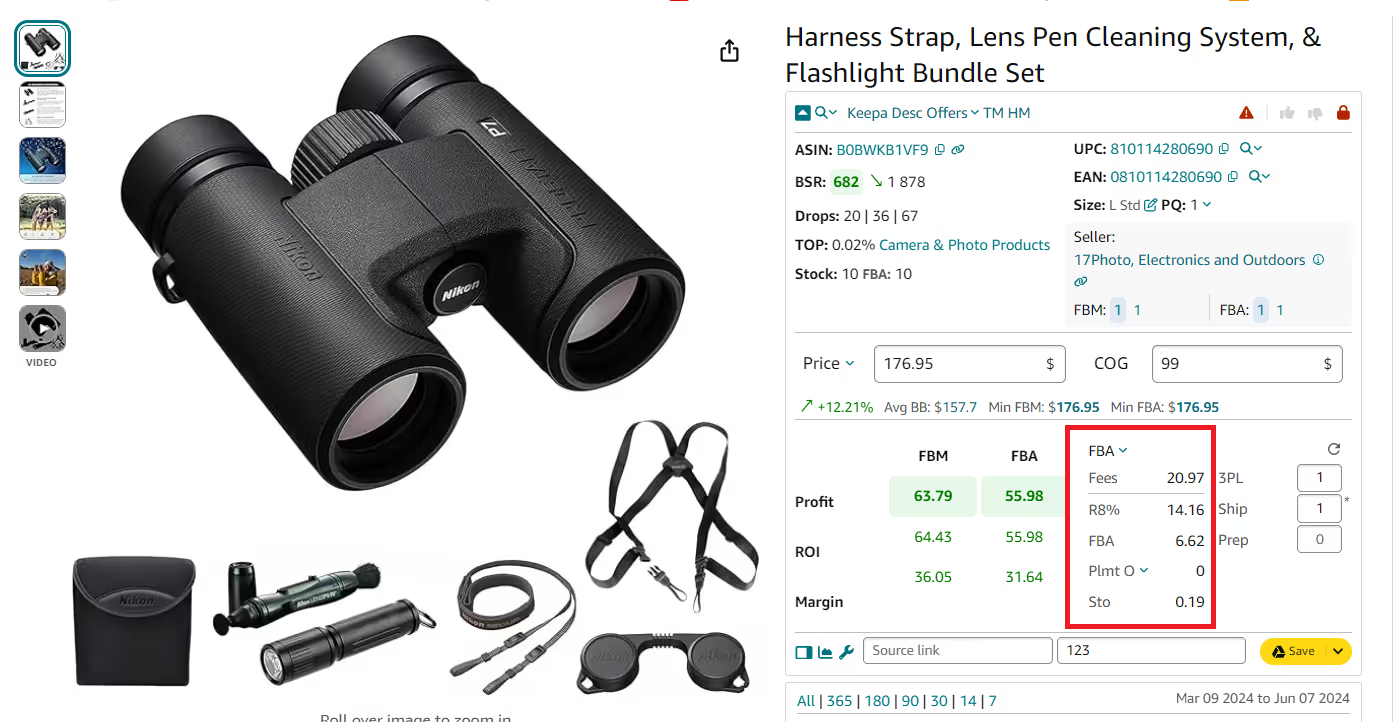
For FBM, enter logistics costs: add 3PL (Ship + Prep + Frgl) and shipping costs, for FBA add prep center fees (if you use that service), and shipping to Amazon costs.
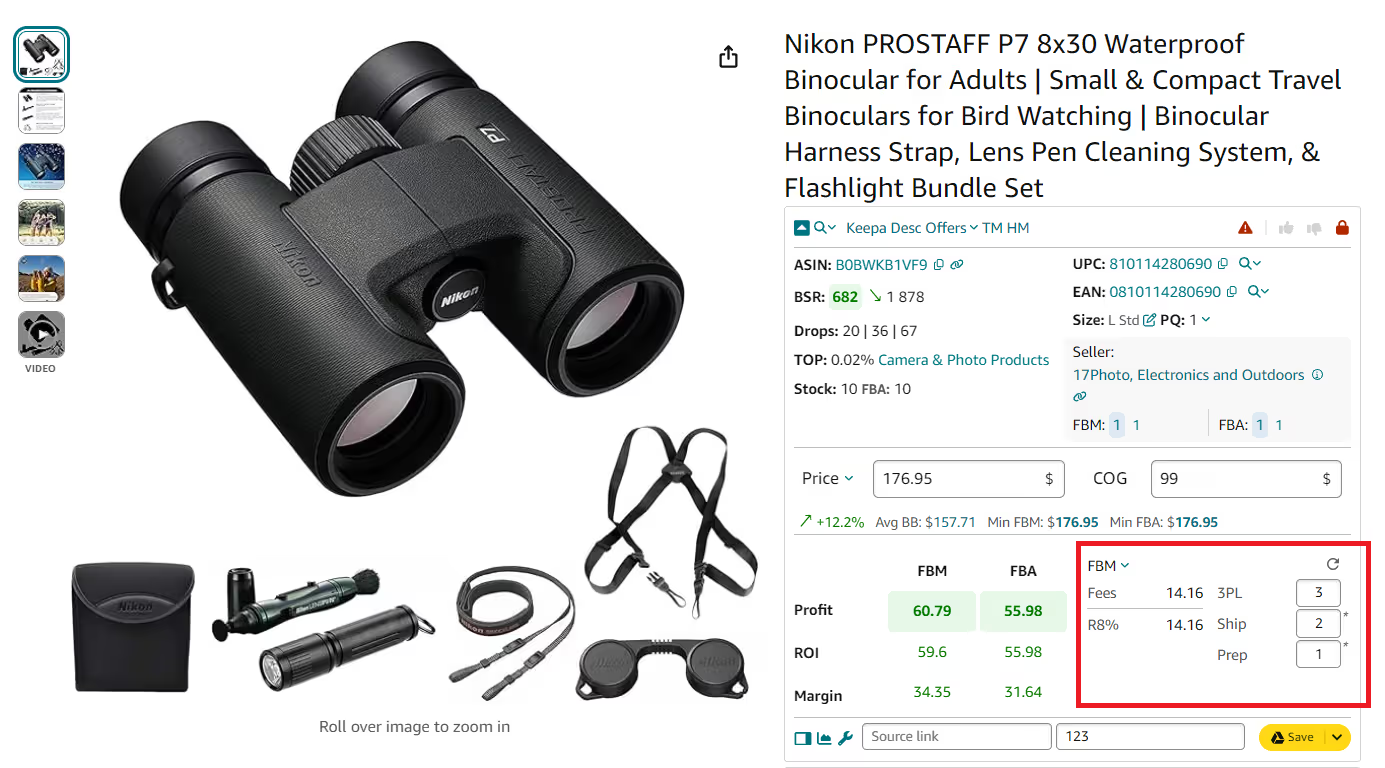
Step 3. Compare FBA and FBM fees
The calculator will show you total Amazon fees for FBA and FBM and their breakdown. Compare which option is lower.
Step 4. Compare your FBA and FBM profit and margin
To see which option is more profitable, look at the profit, ROI, and margin figures in your calculator.

What Is More Popular – FBA or FBM?
Generally, FBA is more popular, with a higher percentage of sellers using it exclusively and in combination with FBM. The figures from the research below indicate that FBA’s convenience and the benefits of Amazon’s logistics network make it a preferred choice for many sellers, although a significant number also see value in the flexibility that FBM offers.
Popularity of FBA vs. FBM
FBA
- 82% of Amazon sellers use FBA in some capacity;
- 64% of sellers exclusively use FBA, highlighting a significant preference for Amazon's fulfillment services;
- 22% of sellers use a combination of both FBA and FBM, indicating that many sellers find value in leveraging both methods for different product lines or strategic purposes.
FBM
- 34% of Amazon sellers use FBM for fulfilling their orders;
- 14% of sellers exclusively use FBM, showing that a smaller, but notable, segment of sellers prefers to manage fulfillment independently;
- 22% of sellers use both FBA and FBM, suggesting a hybrid approach where sellers might utilize FBM for certain products while relying on FBA for others.
Can Sellers Use Both FBA and FBM?
You can use FBA, FBM, or both for your product fulfillment. In fact, many sellers are doing that. The choice depends on your Amazon business scale and the exact product you sell. FBA vs. FBM has pros and cons, and you should use the best solution for each item you sell.
Moreover, you can sell different units of one and the same product with FBA and FBM by adding FBM to your FBA listing.
FAQ
How can I identify a FBA or FBM seller?
You can do that with Amazon product sourcing software. Seller Assistant’s Offers feature shows all offers of a specific product, including seller fulfillment type: FBA or FBM. It also shows the FBA and FBM seller offers count for each product on the Amazon search and product pages, and in the Side Panel View on any website.

How much does Amazon charge for FBM?
FBM sellers must pay a monthly account fee of $39.99 or a fee per sale of $0.99. Amazon also charges a referral fee for each item sold through FBM, typically ranging from 6% to 45% of the product’s sale price, depending on the category. Additionally, sellers are responsible for their own shipping costs and any other fulfillment-related expenses.
Can you sell FBA and FBM?
Yes, you can sell using both FBA and FBM on Amazon simultaneously. This allows sellers to leverage the benefits of Amazon’s fulfillment services while also managing their own shipping for specific products.
Why is Amazon FBA better?
Amazon FBA is better because it offers hassle-free order fulfillment, including storage, packaging, and shipping, while also making products eligible for Amazon Prime badge, which can increase sales and visibility. Additionally, it provides comprehensive customer service, allowing sellers to focus on other aspects of their business.
Is it cheaper to use FBA?
Using FBA can be more cost-effective for high-volume sellers due to economies of scale and reduced shipping costs per unit, but the associated fees can make it more expensive for low-volume or large, heavy items. Ultimately, the cost-effectiveness depends on your specific product and sales volume.
When to use FBA?
Use FBA when you have high sales volume and want to streamline logistics, taking advantage of Amazon’s warehousing, shipping, and customer service. It’s also beneficial if your products are standard-sized and you want them to be eligible for Amazon Prime, increasing their visibility and sales potential.
Final Thoughts
FBA and FBM both have their advantages and disadvantages. Each of them is good for specific businesses and types of products.
The best way to choose between FBA and FBM is to calculate your expenses and see what’s more profitable. Seller Assistant helps with that.
Seller Assistant is an all-in-one product sourcing software offering all the features vital for product sourcing. It combines three extensions: Seller Assistant Extension, IP Alert, and VPN by Seller Assistant, tools: Price List Analyzer, Brand Analyzer, Seller Spy, Bulk Restrictions Checker, and API integrations, and features: Storefront Widget, Side Panel View, FBM&FBA Profit Calculator, Quick View, Stock Checker, IP Alert, Variation Viewer, Sales Estimator, Offers, Restrictions Checker, and other features that help quickly find high-profit deals. Seller Assistant also offers integration with Zapier allowing to create custom product sourcing workflows.
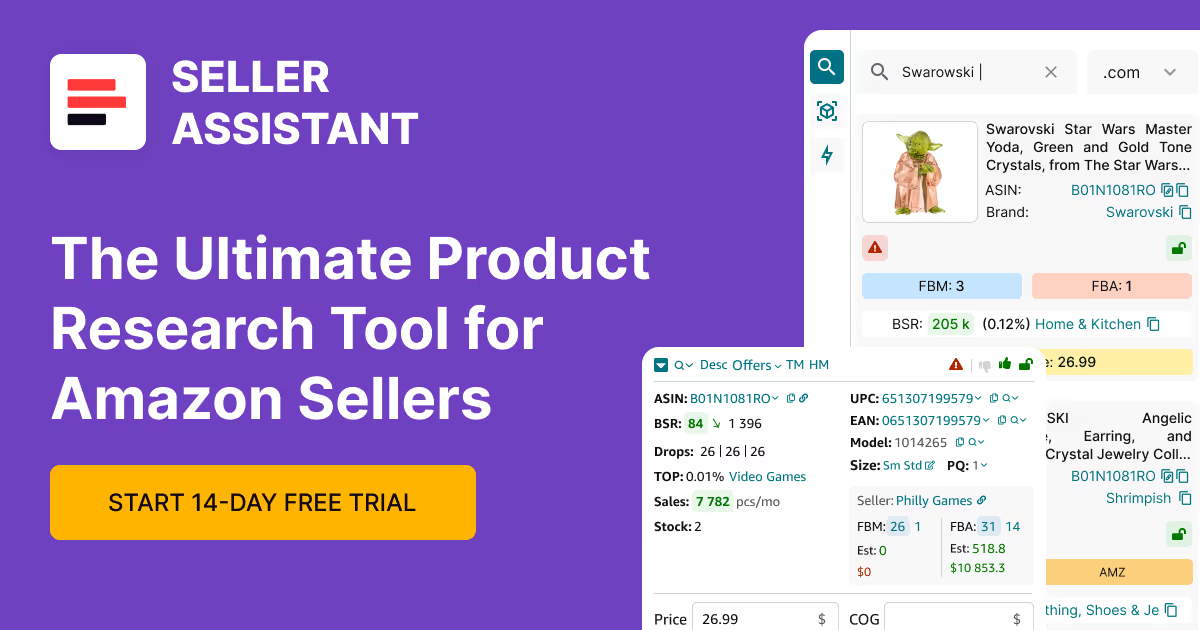
.svg)













